How to care for rhododendron in the garden and how to protect from disease (with video)
When caring for rhododendrons, it is worth remembering that all these plants are moisture-loving, prefer partial shade and grow well only on acidic soil. Ash and any manure (with the exception of the mullein), as well as feeding the plants with them, cannot be brought under them - destroy them immediately and forever.
In the North-West, as a rule, with a good layer (10 cm) of mulch, abundant watering of rhododendrons is not required, except for the flowering period, when they should be watered heartily (10 liters under a bush), so that the root ball is completely saturated with water, then there is a soil should always be moist at a depth of 20-30 cm. Before flowering, only in dry and hot weather should be done periodically spraying with slightly acidified water.
Ekoberin acts very well on rhododendrons, both during freezing and sunburn. This preparation, together with the "Healthy Garden" preparation, should be prophylactically sprayed on rhododendrons, both deciduous and evergreen, in the fall before the shelter and in the spring immediately after the shelter is removed. To prepare the solution, it is enough to dissolve two or three grains of each in one liter of water.
Plants are not susceptible to common diseases that other plants suffer from. The only disease of rhododendron is root ball rot as a result of prolonged waterlogging of the soil or damage from frost or sun.
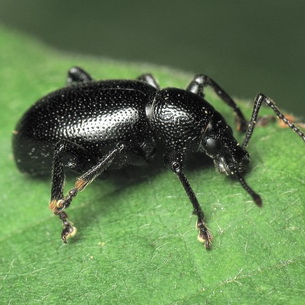
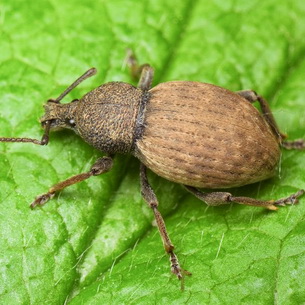
Of the pests, only the beetle is dangerous, which, feeding at night, hides in the soil during the day. He eats buds, buds, flowers and young shoots. To combat diseases and pests of rhododendrons in the evening, plants should be sprayed with a biological product "Fitoverm" (or "IskraBio") twice in 2-3 weeks from the moment the buds appear. The soil under the plants can be watered with karbofos.
The video "Caring for rhododendron" shows the main agricultural techniques:
Preparing for winter
Before wintering, deciduous varieties are watered abundantly throughout the fall.
Young seedlings need good shelter for the winter. Cover the roots and root collar with a thick layer of mulch. The branches are protected from wind and frost with lutrasil or spandum.
The roots of an adult plant require an additional layer of needles from 5 to 20 cm in height. For the branches, a frame is constructed from boards or rods, which will not fit snugly against them.
From above, the frame is covered with a spandum, leaving a hole for ventilation.
Rhododendrons sheltered for the winter
It's important to know! Shrubs should be insulated with a stable decrease in temperature to -10 ° C. With the onset of spring, it is important to monitor the weather - if the air has warmed up enough, and the soil is still frozen, then you need to turn on warm watering to actively awaken the root system of the bush
With the onset of spring, it is important to monitor the weather - if the air has warmed up enough, and the soil is still frozen, then you need to turn on warm watering to actively awaken the root system of the bush
Outdoor wintering
In order to preserve the rhododendrons during the winter, they need to create an appropriate shelter. First you need to insulate the roots of the plant. To do this, create a protective layer of peat or dry foliage about fifteen centimeters thick. Then arcs are installed over the bushes, and they are tightened with non-woven covering material. After the air temperature settles at minus ten degrees, the shelter is closed with a thick film and again fixed from above with arcs. If possible, you can further cover the structure with snow.
With the onset of spring, the shelter is removed, but this must be done gradually. It can be completely removed only after a good warming up of the soil, and preferably on a cloudy day, so that the bright sun does not burn the tender young leaves. Compliance with these wintering conditions guarantees good growth and very abundant flowering.
Planting a rhododendron
Where and when is the best place to plant rhododendron
In our climate, it makes sense to grow rhododendrons in the garden exclusively winter-hardy. Planting rhododendron in the ground is carried out from April to mid-May, as well as from September to November. Actually, if necessary, this can be done at any time period of the growing season, with the exception of the time when the rhododendron blooms, and within one to two weeks after flowering. It is better to plant rhododendron in the shade, on the north side of the building, in loose, well-drained acidic soil rich in humus.
If the groundwater in your area lies at a depth of less than one meter, the rhododendron is planted on a raised bed.
Rhododendron neighbors can be pine, oak, larch - trees with a root system extending into the depths. Trees such as linden, chestnut, alder, maple, willow, elm or poplar will deprive the rhododendron of the nutrition it needs because its roots will feed at the same depth as the roots of the rhododendron. If there is no way to avoid such a neighborhood, you will have to protect the root system of the rhododendron by digging roofing material, slate or polyethylene into the ground. Garden trees - apple trees, pears, are considered good neighbors for rhododendron.
How to plant a rhododendron
A thoroughly mixed mixture of 8 buckets of high-moor peat and 3.5 buckets of loam is poured into the planting hole with a diameter of about 60 cm and a depth of about 40 cm (you can replace the loam with two buckets of clay). The mixture at the bottom of the pit is carefully rammed, and then a hole is dug in it, corresponding to the size of the root ball of the seedling. Before planting, immerse the rhododendron seedlings in water and keep them there until no more air bubbles. Then place the roots of the seedling in the hole, fill the hole to the top with the substrate, tamping it down so that no voids remain. The root neck of the rhododendron should eventually be at the level of the surface of the site.
Water the bush abundantly if you planted rhododendron in dry soil so that the soil is soaked 20 cm deep, and mulch the trunk circle with peat, oak leaves, moss or pine needles with a layer of 5-6 cm.If there are many flower buds on the bush, part remove from them in order to direct the forces for successful rooting, and not for the flowering of the rhododendron. When planting alone in a spacious area, so that the wind does not sway the newly planted plant, you need to stick in a support, tilting it towards the direction of the most frequently blowing winds, and tie a seedling to it. As soon as the bush takes root, the support can be removed.
Landing
Rhododendron is a spectacular plant that can be both a tapeworm and part of a green composition. Bushes can be planted near paths and in recreation areas. For planting, it is necessary to choose shaded areas near the water under the wide crowns of pines and spruces, which will protect from cold and strong wind currents. The heat-loving bush has a negative attitude towards excessive illumination and direct sunlight.
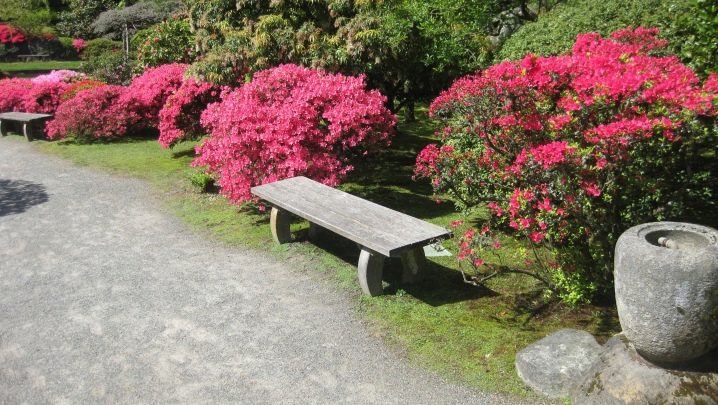
Rhododendron will not grow in wetlands with high moisture levels. If the groundwater is located in the upper layers of the soil, then drainage must be placed at the bottom of the planting pit, which will become an obstacle to root decay. The soil at the planting site should have a high level of acidity and a loose structure.

It is strictly forbidden to use ash and lime, which significantly reduce the acidity of the soil.
Experts advise to purchase planting material in specialized nurseries. In this case, the purchased plants will fully comply with all the declared varietal characteristics.A seedling with a closed root system has a higher chance of taking root and growing quickly. The bush should be of medium size, strong and developed stems, as well as a large amount of green mass without spots and signs of disease.
The beginning of spring is a good time for planting in open ground. The depth of the planting hole must be 55 cm height and 75 cm width, and the minimum height of the layer with coarse drainage should be 15 cm. When planting, it is strictly forbidden to deepen the root collar, and after watering, the root zone must be covered with bark or other mulch.
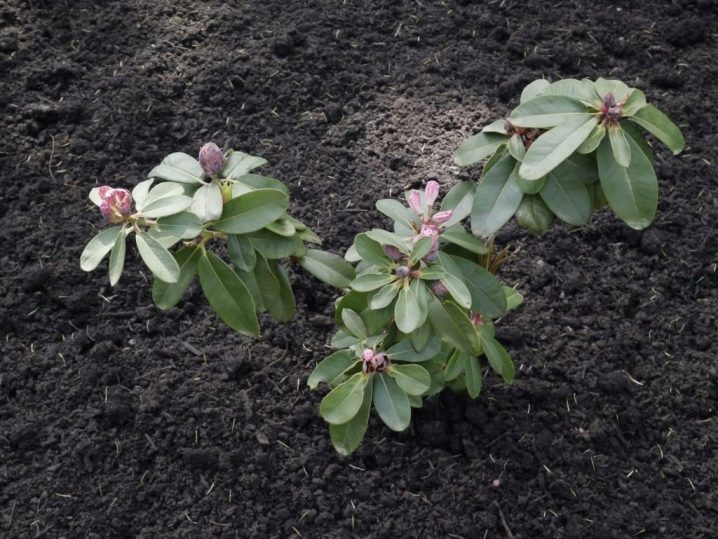
Planting rhododendrons: time, soil, lighting
Following general recommendations, planting can be done both in autumn and in spring, that is, during a convenient growing season for you, excluding flowering time and a short period after flowering - about 10 days. However, experienced gardeners still insist on a spring planting, which continues, depending on the region, from April to May 10-15.
Varieties planted earlier than this period are already covered with a dense color by the May holidays - against the background of barely hatched foliage and fresh grassy greens, they look very impressive.
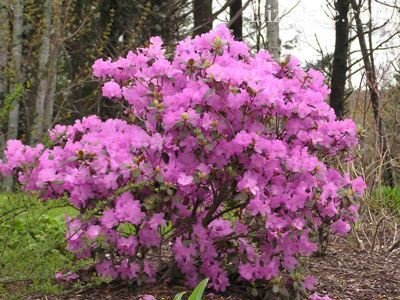
One of the early flowering rhododendrons is P.J. Mezitt is a lush plant with pink and lilac buds. The beginning of its flowering falls on the last decade of April - early May.
It is important to choose the right landing site, since in the bright sun the plant will feel uncomfortable, and in a completely darkened place it will not give a lush flowering. It is best to break a flowerbed with rhododendrons on the north side of the building, in a semi-shaded area, so that at noon, when the sun's rays reach maximum strength, the plant is completely closed from them
It is best to break a flowerbed with rhododendrons on the north side of the building, in a semi-shaded area, so that at noon, when the sun's rays reach maximum strength, the plant is completely closed from them.

Not only the walls of a building, but also a fence or tall trees can serve as a shadow barrier for a flower garden. Rhododendron gets along well with trees, the roots of which go deep into the soil and do not interfere with the development of the plant - oaks, larch, spruce, as well as fruit trees - pears or apple trees
Flowers absolutely cannot stand alkaline or neutral soil - it must be acidic, rich in humus, well aerated, without lime admixtures. One of the best growing materials is a mixture of peat and clay.
Rhododendron is planted in the following order:
- dig holes, shallow (35-40 cm) and wide enough (55-60 cm);
- the lower part is drained with a sandy-pebble layer (10-15 cm);
- they are covered with a mixture of loam and peat (high moor or sphagnum, with low acidity), while peat should be about 2 times more;
- lightly tamp the soil inside the pit and make a hole in it the size of an earthen lump of the seedling;
- the roots of the seedling are lowered into the hole and covered with soil mixture to the very root collar, which, as a result, should be on the same level with the soil surface;
- water the plant abundantly if the soil is dry;
- produce mulching (to a depth of 5-7 cm), for which peat, moss, rotted needles, leaves and crushed oak bark are suitable.
In order for the plant to better take root in a new place, soak the roots thoroughly with water before planting - lower the seedlings in a container with water until air bubbles stop appearing on the surface.
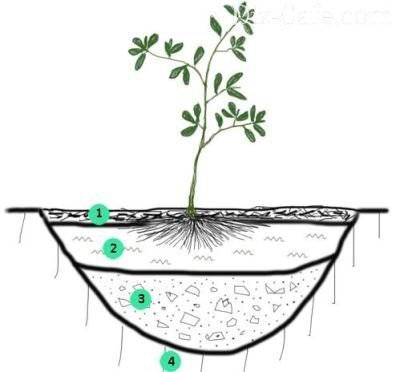
An approximate scheme for planting a rhododendron: 1 - garden soil; 2 - drainage; 3 - soil mixture of peat, clay or loam; 4 - a layer of pine needles
There is one more trick to promote better root development. Cut off the most lush buds of a flowering plant - this way the seedling will spend more energy on rooting. Planting and further caring for rhododendrons are important steps, following which you will achieve amazing results.
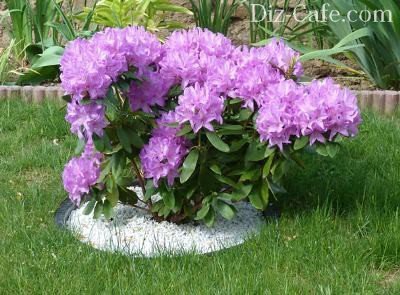
It is better to start decorating a planted bush in a couple of weeks - after it is completely rooted. You can give the plant a certain shape, and decorate the base depending on the style of landscape design of your site
Choosing seedlings
Young seedlings are best purchased from trusted sellers so as not to get a sad breeding experience.
The most successful will be seedlings grown in pots or outdoors in the same climate where the future bush will grow.

Saplings of deciduous rhododendron
It's important to know! If the plant is grown in greenhouses, it will not adapt to growing conditions outdoors and will die quickly. To increase the likelihood of good rooting and growth of the future bush, the seedling should be:
To increase the likelihood of good rooting and growth of the future bush, the seedling should be:
- age 2-4 years;
- well bushy, and the shoots should move away from the very base of the trunk of the bush;
- with smooth, healthy leaves of a dark green color (when purchased in the fall, color in yellow, red tones is possible);
- with healthy roots, no signs of rot and dark spots.
Young bushes grown in the right conditions will be short:
- grown from seeds - 12-15 cm in height;
- obtained by cuttings - 20-25 cm.
It's important to know! If a 4-year-old seedling is about a meter high, this is a sign of greenhouse cultivation.
Landing in open ground
In our area, rhododendron of frost-resistant varieties will grow well. The rest of the crops can die with the onset of cold weather. Disembarkation takes place in early spring, October-November. In principle, the procedure can be carried out at any time, with the exception of the flowering period.
The landing looks like this:
- Dig a hole 50 centimeters deep.
- Prepare a soil mixture of clay, peat, place it inside. Then tamp the groove, dig a hole, the dimensions of which correspond to the root system.
- Be sure to keep the sprouts in water before planting - the likelihood that they will sprout will increase.
- The planted bush is covered with earth, trampled down tightly. Be careful not to bury the root collar. It should be flush with the surface.
- Water liberally.
Deciduous rhododendrons grow well in the shade, in acidified and mineral-rich soil. The best neighbors are:
- Oak, pine.
- Fruit trees.
- Trees with roots at a decent depth.
 Rhododendron, open field planting
Rhododendron, open field planting
Refrain from planting with alder, maple, chestnut. They will destroy the flower.


